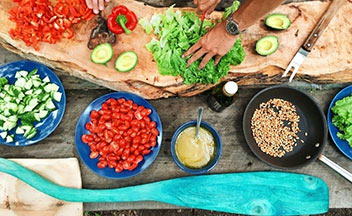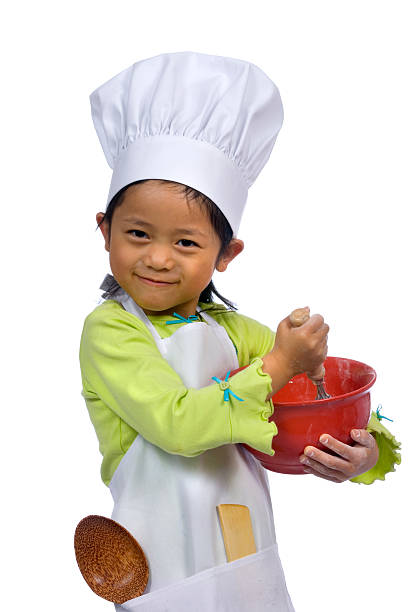
In my last article, I discussed the importance of cooking skills 101, and how Chef de Cuisine Joey Delago's class explains each task and its associated skill. I have discussed the tasks-based categories of skills in cooking, as well as their applications. These skills are important for any cook. A list can help to decide which skills to focus on and which ones not. In this article, I'll talk about some of the skills you should master before embarking on the next level of your culinary journey.
Chef de Cuisine Joey DeLago's cooking skills 101 class
Chef de Cuisine Joey DeLago's 101 cooking skills class will teach you how to cook like a pro. This hands-on class focuses on the basic culinary skills you need to make a multi-course meal in a pinch. Joey will offer tips and tricks on how to plan, prep, time, present, and more. Plus, you will be able to share the finished meal with other home-cooks!
Task-centred categories of cooking skills
The Food Agency defines cooking abilities as the combination of knowledge, skills, practices, and techniques that support a healthy diet. Although the environment can be a barrier to a healthy diet, this framework focuses on how to promote food skills and identify appropriate measures. These measures should be easy to understand, relate to other domains, and be applicable across a wide range of sociodemographic levels. The following four categories are designed to address some of most pressing issues concerning food skills.

Activating yeast
You will need to know how activate yeast if you want to use it in your cooking. To activate the yeast, heat some water from your tap and then run some hot water through it. In some cases, you may need to add water or sugar to the yeast. These are some ways to activate yeast. Once your yeast is bubbly, it's ready to be used. It is essential to activate yeast during cooking for baking success.
Making stocks
Stock can give your dishes more depth and flavor. Stocks can be made using vegetables, meat, and seafood. While you can make your own stock using bottled water, it is better to use the filtered water available at the grocery store. There are many stock recipe options, but it is important to know the basics to ensure your stock tastes as good as possible.
Whipping cream
Whipped cream is an excellent way to finish off a cake or dessert. This classic dessert is simple to make but you need to be careful. While it looks like slightly melted ice cream, it's not. Instead of a sloppy consistency, whipped cream should be a fluffy, slightly curved peak that sticks to the whisk and doesn't dissolve right away. You can also make soft peaks by beating the cream with a spoon until it holds its shape and does not slack off.

Melting chocolate
If you want to create delicious desserts, then learning how to melt chocolate should be on your list. It is not an easy task. These tips will help you to get the job done quickly with minimal mess. First, you need to know the correct method. There are two methods to melt chocolate. The microwave and double boiler methods. Double boiler refers to a heatproof container or pan with a glass- or stainless-steel-bottom that is placed over a pot of simmering, boiling water. This should be done slowly. The water should not splash into the bowl.
FAQ
Do I require any special equipment?
Cooking doesn't require special equipment. However, it can be easier to use the right tools. For example, you could use a knife instead of a fork to eat pasta or a whisk instead of a hand mixer to whip egg whites into stiff peaks. Having the right tools can make cooking less daunting and allow you to get started faster.
How Much Does it Cost to Learn Culinary Arts Skills?
You will find that the price to study culinary arts is variable. For example, a 4-year degree costs about $40,000. On the other hand, a two-year associate's degree may cost less than $5,000. Tuition rates depend on the type of program you select. The prices charged by private institutions are generally higher than the public.
How can I learn how to cook like a professional chef?
Cooking is one way to be a better cook. You can increase your self-confidence by learning how to cook healthy foods for yourself and others. Start cooking at home if you want to learn how to cook. The first step is to find out what kind of recipes you like. You can then read books about other cuisines like Mexican, Chinese and Italian. Finally, practice making different dishes until you feel comfortable doing them.
Is there a better way to learn to make delicious meals?
Cooking is one of those things that everyone should know how to do. Cooking is a skill that will allow you to enjoy delicious food. When learning how to cook, the first thing to do is find a recipe you love and follow it closely. Next, practice making small changes until you are comfortable cooking the dish. Next, you can cook for others. This will help you improve at cooking and also allow you to test your skills.
Is there a difference in a chef and a cooker?
A chef prepares meals for others. A cook prepares meals for others. While both jobs involve preparing food, a chef works directly with customers. This means they may have to decide what to serve guests based on their preferences. The cook does not have to interact directly with customers. Instead, a cook makes sure the food tastes good before delivering it to customers.
Statistics
- You'll be amazed that over 90% of CIA students receive scholarships and grants to finish their culinary studies. (ischoolconnect.com)
- In the United States, the category is estimated at $23.2 billion annually and is growing faster than the market. (washingtonpost.com)
- On average, chefs earn $58,740 a year, according to the BLS. - learnhowtobecome.org
External Links
How To
How to make a perfect omelet
Omelets is one of my favourite breakfast foods. But how do they turn out so perfectly? I've tried many recipes and different methods but none have worked. So I am sharing some tips and tricks today to help you make fluffy, delicious omelets every morning.
First, eggs can be very temperamental ingredients for making omelets. Eggs must be purchased fresh, preferably organic, and kept chilled until ready for cooking. The yolks and whites will not form properly if they aren't kept cold enough. This makes your omelets look weirdly colored. If you're going to cook them immediately, it is best if the eggs are still warm.
Another tip is to separate each egg before adding them to the saucepan. You don't want the white to get mixed with the yolk, as this could cause the egg to curdle.
You could end up burning the bottom half of the egg if the egg is added directly to the heat source. Instead, heat the egg for 10 seconds in the microwave before placing it in the pan. The microwave heat cooks the eggs just right without overcooking them.
Let's now talk about mixing eggs. Mixing eggs together is important. You need to beat them well. To do this, take the bowl from the mixer and flip it upside-down. Then shake the bowl vigorously. The egg will be thoroughly mixed in the bowl as the air is whipped.
The fun part is now - adding the milk to the mixture. First, pour half of the milk into the beaten eggs and then fold the eggs gently into the remaining milk. Don't worry if there are still streaks of egg visible; these streaks will disappear once you flip the omelet.
After you have folded the eggs, heat the oil in a pan over medium heat. Once the oil has started to sizzle, turn the heat down to low. When the oil is hot enough, add 1/4 cup butter to the pan. Stir it around until the butter covers the entire pan. The lid should be carefully opened. Sprinkle salt in the pan. A pinch of salt will help prevent the omelet from sticking to the pan.
Cover the pan once the omelet is formed and allow it to cool completely. Flip the omelet over using a spatula or flip the pan upside down. Cook the other side for another minute or two. Serve immediately after removing the omelet from its pan.
This recipe is best when used with whole milk. But, you can use skimmed milk as well.